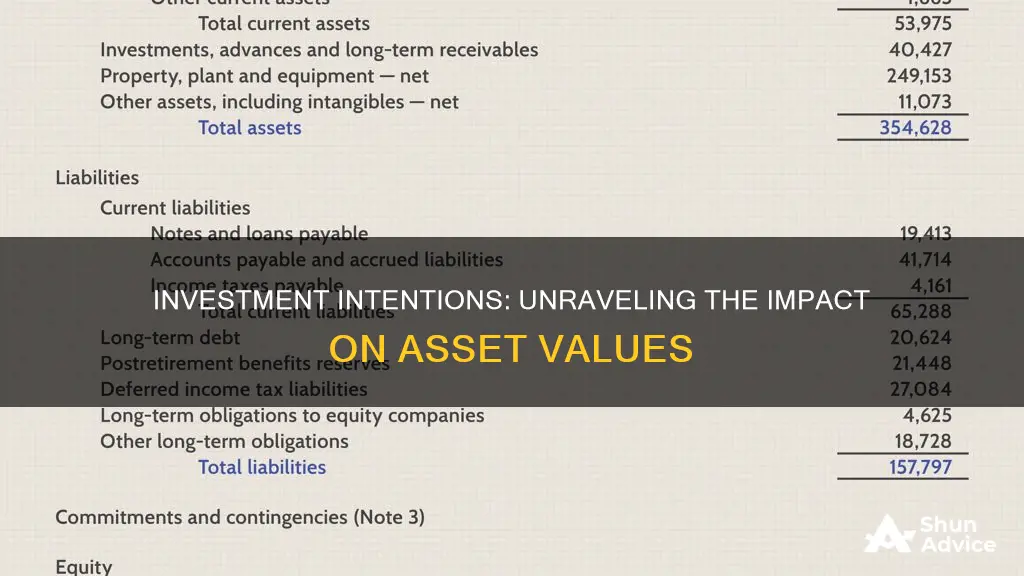
Owners' equity is the amount of ownership an individual or entity has in a company after subtracting liabilities from assets. An owner's investment in a company will increase its assets and, subsequently, the owner's equity. This is because the investment introduces more assets than liabilities, thus increasing the overall value of the company. However, it is important to note that owners' equity does not represent the market value of a company, as assets can either depreciate or appreciate over time.
| Characteristics | Values |
|---|---|
| Owner's equity | The amount of ownership in a business after subtracting liabilities from assets |
| Liabilities | Debts owed by the business, e.g. loans, accounts payable, and mortgages |
| Assets | Items of value owned by the business, e.g. cash, cars, and intellectual property |
| Accounting equation | Assets = Liabilities + Owner's (Stockholders') Equity |
| Owner's investment | An increase in the company's assets and owner's equity |
| Borrowing from a bank | An increase in the company's assets and liabilities |
| Repaying a loan | A decrease in the company's assets and liabilities |
| Paying cash for a new asset | A decrease in one asset (e.g. cash) and an increase in another (e.g. vehicles) |
| Providing a service and receiving immediate payment | An increase in the company's assets and owner's equity |
| Providing a service and allowing the client to pay later | An increase in the company's assets (Accounts Receivable) and owner's equity |
| Incurring an expense | A reduction in owner's equity and an increase in liabilities |
What You'll Learn

Owner's investment increases company assets and owner's equity
Owners' investment, also referred to as owner's investment or contributed capital, is the number of assets that an owner puts into a company. This can be in the form of monetary funds or other assets that are contributed to either start the business or keep it running.
The accounting equation is Assets = Liabilities + Owner's (Stockholders') Equity. This equation should always balance due to the double-entry system of accounting or bookkeeping. When an owner invests in a company, the company's assets increase, and this also increases the owner's equity. This is because the owner's equity is calculated by subtracting liabilities from assets. Therefore, an increase in assets results in a higher value for the owner's equity.
For example, if an owner invests their own money when starting a company, they will receive shares proportionate to their investment. They can also increase their investment at a later date, resulting in additional shares. This is known as paid-in capital.
Owner's equity can also be generated through retained earnings. Companies may retain a portion of their profits and add this to the company's equity, rather than paying it out as dividends to shareholders.
Apple Pay's Evolution: Why Investing in Research and Design is Key
You may want to see also

Company borrowing increases assets and liabilities
When a company borrows money, its assets and liabilities both increase. This is because the borrowed money is considered an asset, while the loan is considered a liability. This is reflected in the company's balance sheet, where the total assets will equal the sum of the company's liabilities and shareholders' equity.
The accounting equation, which is the foundation of the double-entry accounting system, states that a company's total assets are equal to the sum of its liabilities and shareholders' equity. This equation ensures that the balance sheet remains balanced, with each entry on the debit side having a corresponding entry on the credit side.
In the context of the accounting equation, assets represent the valuable resources controlled by a company, while liabilities represent its obligations. Financing through debt will show as a liability, while financing through issuing equity shares will appear in shareholders' equity.
For example, if a company takes out a loan from a bank, the borrowed money will be reflected as an increase in the company's assets and an increase in its loan liability. On the other hand, if a company repays a loan, its assets and liabilities will both decrease.
It is important to note that liabilities and shareholders' equity represent how the assets of a company are financed. Liabilities are debts that a company owes and costs that it needs to pay to keep the company running. Shareholders' equity, on the other hand, is the total value of the company expressed in dollars, or the amount that would remain if the company liquidated all its assets and paid off all its debts.
Fees and the Long Game: Understanding the Impact on Retirement Savings
You may want to see also

Repaying loans decreases assets and liabilities
The accounting equation states that a company's total assets are equal to the sum of its liabilities and equity contributions. In this equation, liabilities and equity are interchangeable, as they live on the same side of the equation. So, if a company repays a loan, its liabilities will decrease, but its assets will also decrease by the same amount, assuming the loan is repaid from the company's cash assets.
For example, let's say a company has $100,000 in assets, including $20,000 in cash, and $50,000 in liabilities, including a loan of $20,000. If the company repays the loan in full, its liabilities will decrease by $20,000, but its assets will also decrease by $20,000 (the cash used to repay the loan), leaving the company with $80,000 in assets.
It's important to note that the accounting equation assumes that the company's assets, liabilities, and equity are valued at their original purchase price, not their current market value. Over time, assets may depreciate or appreciate, which can affect the company's true financial health and value.
In addition, while repaying a loan can decrease both assets and liabilities, it can also have a positive impact on the company's financial health by reducing its debt obligations and improving its debt-to-equity ratio. A lower debt-to-equity ratio can indicate that a company is in a more stable financial position and may be more attractive to creditors or investors.
From the lender's perspective, a loan is considered an asset because it represents a future stream of income in the form of interest and fees. When a loan is repaid, the lender's asset (the loan) is reduced, but they have received cash in return, which can also be considered an asset.
In summary, repaying loans can decrease both assets and liabilities, but it's important to consider the broader financial implications, such as improved debt-to-equity ratios and the impact on the lender's asset portfolio.
Jio: India's Digital Revolution
You may want to see also

Owner's withdrawal of assets decreases owner's equity
Owners' equity, also referred to as net worth, equity, or net assets, is the amount of ownership one has in their business after subtracting liabilities from assets. Liabilities are debts that a business owes, such as loans, accounts payable, and mortgages, while assets are anything the business owns, including cash, cars, and intellectual property.
When an owner withdraws assets from their business for personal use, it results in a decrease in owners' equity. This is because the withdrawal represents a reduction in the assets of the business, without a corresponding decrease in liabilities. This type of withdrawal is not considered a business expense and does not appear on the sole proprietorship's income statement.
For example, if a business owner withdraws cash from the business to purchase a personal vehicle, the amount withdrawn is deducted from the business's assets. This directly reduces the owners' equity, as the assets available to cover liabilities have decreased.
It's important to note that while owners' equity provides valuable information about the business's financial position, it does not reflect the market value of the business. The market value considers the appreciation or depreciation of assets over time, which may differ significantly from the book value used in calculating owners' equity.
To summarize, owners' withdrawal of assets for personal use decreases owners' equity by reducing the total assets of the business without a corresponding reduction in liabilities. This impacts the overall financial health and ownership position of the business.
Investing in Educators: A Guide to Supporting Teacher Retirement
You may want to see also

Company profits increase owner's equity
Owners' equity is a measure of how much ownership a company's owners have in the business. It is also referred to as net worth, equity, or net assets. Owners' equity is calculated by subtracting a company's liabilities from its assets. Liabilities are debts the business owes, such as loans, accounts payable, and mortgages. Assets are anything the business owns, such as cash, cars, and intellectual property.
Owners' equity is important because it helps owners understand the value of their stake in the business and evaluate their finances. It is listed on a company's balance sheet and can be used to track whether the company is gaining or losing value over time. A positive and increasing owners' equity indicates a healthy, growing company, while a negative owners' equity can signify that a company has more liabilities than assets.
Company profits increase owners' equity. When a company earns a profit, its owners' equity rises, and when the company suffers a loss, the owners' equity falls. Profit is calculated as revenue minus expenses. If expenses increase and revenue stays the same, the company's profit declines, and there is less money that can flow to owners' equity. On the other hand, if the company can cut costs without affecting revenue, there will be more money that can go to owners' equity.
Owners can increase their equity by investing more money in the business, decreasing the company's liabilities, or increasing profits.
The Student Debt Dilemma: Invest or Repay?
You may want to see also
Frequently asked questions
Owner's investment, also known as contributed capital, is the amount of money or other assets that the owner puts into the company. This investment increases the company's assets and the owner's equity.
When a company borrows money from a bank, its assets and liabilities increase. Repaying the loan decreases both the company's assets and liabilities.
Owner's equity decreases when the company loses money, when an owner withdraws money for personal use, or when an unusual event occurs that requires replacing assets, such as a natural disaster.







